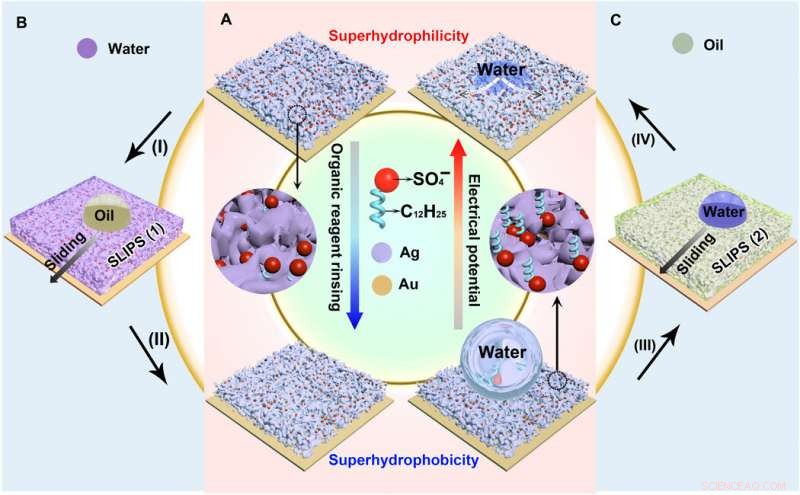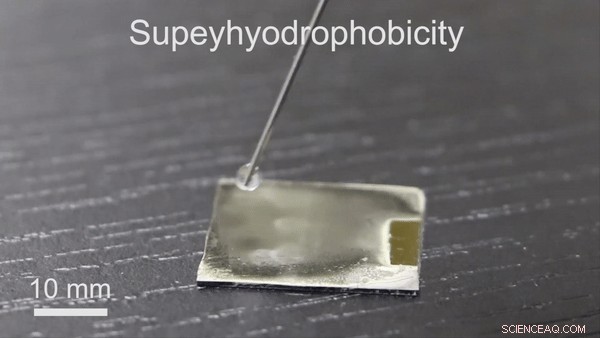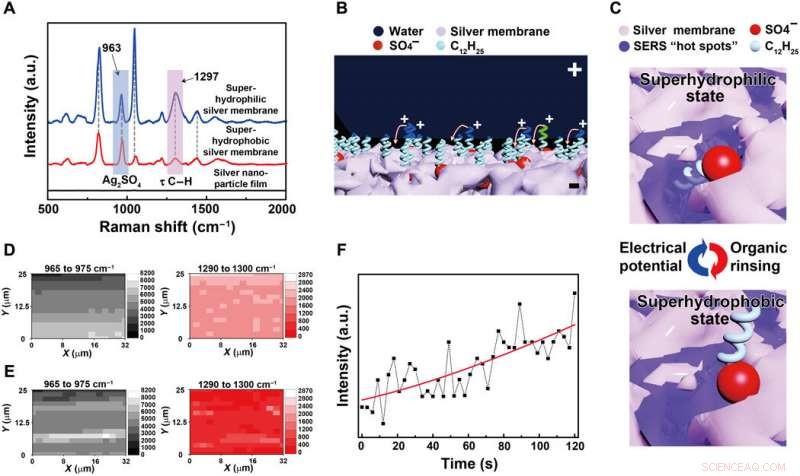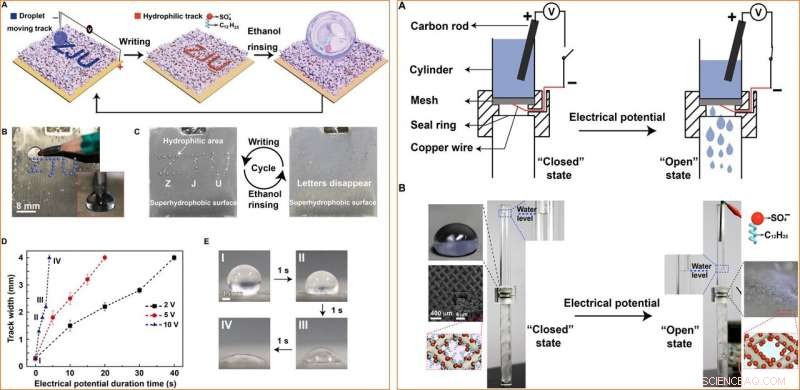
Commutation réversible de la mouillabilité et de la répulsion des liquides des membranes poreuses d'argent électrodéposées. (A) Transition de mouillabilité réversible de superhydrophile à superhydrophobe, permis par le changement d'orientation des ions dodécyl sulfate. (B) SLIPS 1 est formé en infusant de l'eau dans la membrane poreuse superhydrophile (processus I), qui peut repousser l'huile. Après rinçage à l'éthanol (procédé II), SLIPS 1 devient superhydrophobe. (C) L'huile est infusée dans la membrane poreuse superhydrophobe (processus III), formant SLIPS 2. L'eau sera repoussée par SLIPS 2. L'huile lubrifiante sera libérée de SLIPS 2 sous un potentiel électrique (processus IV), donnant naissance à une membrane poreuse superhydrophile. Crédit :Avancées scientifiques, doi:10.1126/sciadv.aax0380
Les technologies d'ingénierie des matériaux visent à contrôler la mouillabilité et la répulsion des liquides des surfaces des matériaux pour diverses applications dans et au-delà du domaine de la science des matériaux. Dans un récent rapport sur Avancées scientifiques , Yue Liu et une équipe de chercheurs des départements de science et génie des matériaux, et la chimie et l'ingénierie moléculaire en Chine ont développé un concept général pour développer des surfaces poreuses métalliques avec une puissance exceptionnelle, capacités de commutateur de mouillabilité. Pour concevoir les nouvelles surfaces, ils ont utilisé une méthode extrêmement simple, procédé de dépôt électrochimique en une étape. L'équipe a activé le commutateur de mouillabilité et manipulé les propriétés répulsives des liquides en modifiant l'orientation des ions dodécyl sulfate qui étaient liés ioniquement aux membranes métalliques poreuses pendant l'électrodéposition. Les surfaces résultantes avec une mouillabilité réglable pourraient piéger divers lubrifiants à la demande dans les pores pour créer des surfaces poreuses infusées de liquide personnalisées pour une variété de propriétés repoussant les liquides. L'équipe de recherche a démontré les applications des membranes poreuses infusées de liquide pour le cryptage, pour contrôler le transfert de gouttelettes et pour la récupération de l'eau. En outre, les scientifiques des matériaux ont enduit la membrane poreuse d'argent sur un maillage de cuivre pour concevoir un système intelligent, porte liquide antifouling pour laisser passer l'huile ou l'eau sur demande.
En génie des matériaux, les chercheurs visent à développer des propriétés interfaciales réversibles pour diverses applications à partir de systèmes microfluidiques, à la collecte et au transport de l'eau, ainsi que des séparateurs, capteurs et systèmes d'administration de médicaments. Les scientifiques des matériaux ont étudié de manière approfondie de telles surfaces à mouillabilité commutable contrôlées par des stimuli externes, notamment la lumière, PH, traitement thermique et électrochimique, contre-ions et potentiels électriques. Dans le travail present, Liu et al. a rapporté une chose extrêmement simple, approche d'électrodéposition en une étape pour concevoir des surfaces métalliques poreuses avec des capacités de commutation de mouillabilité robustes couplées à des propriétés hydrofuges exceptionnelles qui différaient des mécanismes précédemment rapportés pour concevoir un nouveau commutateur de mouillabilité.
Ingénierie de la mouillabilité réversible sur les surfaces poreuses électrodéposées
Liu et al. modulé l'orientation des ions dodécyl sulfate qui se sont liés ioniquement à la membrane poreuse pendant l'électrodéposition pour établir une mouillabilité de surface réglable de manière réversible. Par exemple, lorsque les chaînes dodécyles pointées vers l'extérieur, la membrane a conservé une superhydrophobie (nature détestant l'eau). Ensuite, les chercheurs ont utilisé des potentiels électriques pour faire passer la mouillabilité de l'état superhydrophobe (qui déteste l'eau) à l'état superhydrophile (qui aime l'eau). Ils ont confirmé les changements d'orientation de la surface ionique à l'aide de mesures de diffusion Raman améliorée en surface (SERS). Basé sur l'évolution induite par l'orientation ionique des surfaces poreuses électrodéposées, l'équipe de recherche a fermement piégé divers lubrifiants dans les pores pour former différentes "surfaces poreuses glissantes imprégnées de liquide (SLIPS)" pour de multiples applications.

Fabrication et caractérisation des membranes poreuses en ruban. (A) Image au microscope électronique à balayage de la membrane poreuse d'argent électrodéposée. Encart :Image agrandie. (B) La hauteur de rugosité moyenne arithmétique des membranes d'argent électrodéposées à 1,5 V à différents moments. (C) Les courbes I et II sont les angles de contact avec l'eau sur les membranes poreuses en argent telles que préparées et traitées à l'éthanol préparées à 1,5 V pour des durées différentes, respectivement. La courbe III représente les angles de contact avec l'eau sur le film de nanoparticules d'argent traité à l'éthanol électrodéposé dans des solutions aqueuses de nitrate d'argent pur. (D) La transition de mouillabilité de superhydrophile à superhydrophobe peut être complétée par un traitement avec 25 réactifs organiques couramment utilisés. (E) Angles de contact et angles de roll-off de la membrane poreuse en argent superhydrophile après avoir été traitée par un mélange d'eau et d'éthanol à différents rapports de volume. (F) La transition de mouillabilité de superhydrophile à superhydrophobe et de retour à superhydrophile pendant 10 cycles. (G) La morphologie de la membrane poreuse est inchangée après 10 cycles de transition de mouillabilité. Les barres d'erreur en (C) à (F) sont obtenues sur la base d'au moins cinq mesures indépendantes. Crédit :Avancées scientifiques, doi:10.1126/sciadv.aax0380
La nouvelle technique aura un potentiel important dans diverses applications thermochimiques en raison de sa simplicité d'ingénierie, polyvalence et faible coût. Pour former le commutateur de mouillabilité réversible, les chercheurs ont d'abord déposé par électrolyse une membrane poreuse d'argent sur une plaquette de silicium recouverte d'or dans une solution d'électrolyte contenant du nitrate d'argent et du dodécyl sulfate de sodium (SDS). Au fur et à mesure que la chronologie de l'électrodéposition augmentait, la rugosité de la membrane augmente progressivement, après quatre minutes, la membrane résultante était superhydrophile. With the assistance of organic liquids as well as with water containing a minute amount of ethanol (one percent in volume), the scientists could induce the transition of wettability from superhydrophillic (or superoleophillic; water loving) to superhydrophobic (water hating). The instant transition indicated high sensitivity of the membrane toward organic reagents. The water contact angle also increased (hydrophobic character) when they simply exposed the silver porous membrane to an ethanol atmosphere (i.e organic reagent).

The superhydrophobicity of the organic reagent–treated silver porous membrane. Crédit :Avancées scientifiques, doi:10.1126/sciadv.aax0380
Understanding the mechanism of wettability transition
The research team conduced systematical studies to reveal the underlying mechanisms of wettability transition, first by using Fourier transform infrared spectroscopy (FTIR) and X-ray photoelectron spectroscopy (XPS) for surface analysis. They proved the existence of SDS ions within the silver porous membrane to form a monolayer structure similar to a previously well-studied surface. Liu et al. hypothesized that hydrophobic dodecyl chain tails hid inside the pores of the freshly prepared silver porous membrane– prompting the silver membrane to initially demonstrate hydrophilicity due to the exposed, hydrophilic sulfate heads.
When the superhydrophillic surface then encountered organic reagents such as ethanol, the hidden dodecyl chain tails changed orientation to face the organic liquids due to their mutually strong affinity. Due to challenges of proving the changing orientation of the dodecyl chains on the rough porous membranes using conventional scanning tunneling microscopy or atomic force microscopy, the team used SERS. The SERS intensity, which mapped the interactions between dodecyl ionic chains and silver sulfate surface, confirmed the transition that facilitated the membrane wettability switch. When they removed the dodecyl ions using oxygen plasma treatment, they eliminated the wettability switch from the silver porous membrane.

Mechanism of the reversibly switching interfacial properties. (A) SERS spectra of the silver porous membrane at superhydrophilic state and superhydrophobic state and the electrodeposited silver nanoparticle film in pure silver nitrate aqueous solutions. The SERS peaks located at 963 and 1297 cm−1 are assigned to silver sulfate and the torsional vibration mode (τ) of C─H in the dodecyl chains, respectivement. a.u., unités arbitraires. (B) Schematic illustration of the orientation change of the dodecyl chains under an electrical potential. Positive charges will accumulate at the tips of the dodecyl chains contacting water, rotating them toward the negatively charged silver porous membrane. (C) Schematic illustration of the SERS intensity evolution of the dodecyl chains at different wetting states. At hydrophilic state, dodecyl chains are exposed to the SERS “hot spots” existing within the pores of the silver membrane, resulting in strong SERS signals. At hydrophobic state, the dodecyl chains are far away from the SERS hot spots, demonstrating weak SERS signals. (D and E) The SERS mapping results of silver sulfate and the dodecyl chains when the porous membrane is superhydrophilic and superhydrophobic, respectivement. (F) The intensity evolution of the 1297-cm−1 SERS peak from dodecyl chains at a specific location as the electrical potential was applied to the superhydrophobic silver porous membrane (photo credit:Yue Liu, Zhejiang University). Crédit :Avancées scientifiques, doi:10.1126/sciadv.aax0380
Applications of the technique—encryption and liquid transfer
Having developed a new concept to engineer reversible wettability, the research team developed a variety of applications such as information encryption, droplet transfer, liquid-repellence, fog harvesting, and smart liquid gate as well as oil/water separation. For information encryption, Liu et al. dragged a pencil that behaved as a cathode electrode immersed in a droplet, upon the superhydrophobic surface connected to the positive pole of the power supply to write the letters "ZJU." The surface then transformed to maintain hydrophilicity and when the scientists exposed the surface to water or steam, the encrypted invisible words were revealed due to surface attachment of water droplets. They could change the speed of encryption and remove the hydrophilic track using ethanol to recycle the surface multiple times for reuse. By changing surface properties, they could also induce conditions of hydrophobic encryption. The research team then made use of strong surface adhesion to transfer water droplets across from superhydrophillic surfaces using ethanol-treated silver porous membranes, where droplets adhered on top of the silver membrane for easy transfer.
Harnessing the liquid-repellent properties for additional applications
Après, the research team designed silver porous membranes to change from superhydrophillic SLIPS1 (slippery liquid-infused porous surfaces) to superhydrophobic SLIPS2 to form a repeatable cycle between SLIP1 and SLIP2 surfaces for a desired timeframe. The work described here were a first in study to engineer such complex wetting and liquid-repellent properties with potential for dynamic adjustment to match diverse lubricants. En outre, bioinspired by the Namib desert beetle that used patterned hydrophilic and hydrophobic elytra (hardened forewing) to retain or remove water droplets, Liu et al. patterned stripes of SLIP2 for excellent water repellence. They engineered surfaces to adhere water molecules for nucleation on hydrophilic surfaces upon exposure to water mist for outstanding fog harvesting efficiency.

LEFT:Application in encryption. (A) Schematic of the information encryption process. A water droplet is dragged by a pencil connected to the negative pole of a power supply to write letters ZJU on the superhydrophobic surface connected to the positive pole of the power supply. The track turns hydrophilic. When the porous membrane is immersed in water or exposed to water steam, the ZJU letters will appear. Ethanol rinsing can turn the hydrophilic track superhydrophobic, allowing for repeatable usage. (B) The setup for the encryption application. Inset:A pencil behaving as a cathode immersed in a droplet sitting on the superhydrophobic surface. (C) Repeatable usage of the silver porous membrane in encryption applications. (D) The track width as a function of the duration time at 2, 5, and 10 V. The error bars are obtained on the basis of five independent measurements. (E) Photographs of the track created at 10 V for different times (photo credit:Yue Liu, Zhejiang University). RIGHT:Application as a smart liquid gate. (A) Schematic of the setup of the smart liquid gate. (B) At the beginning, the mesh is at the “closed” state because the silver-coated copper mesh is superhydrophobic. Once the mesh is triggered by an electrical potential, it turns to the “open” state, and water starts to pass through the mesh. Inset:The image of a water droplet on and the orientation of the dodecyl sulfate ions on the silver-coated copper mesh at the closed and the open state, as well as the microstructure of the silver-coated copper mesh (photo credit:Yue Liu, Zhejiang University). Crédit :Avancées scientifiques, doi:10.1126/sciadv.aax0380
Prochain, the scientists electrochemically coated the silver porous membrane onto a copper mesh for applications as a smart liquid gate. While the original superhydrophobicity prohibited the passage of water, when they applied a negative electric potential to the copper mesh, the surfaces became superhydrophilic for the immediate passage of water. The surface property could be interchangeably engineered by exposure to ethanol vapor, for reuse. Liu et al. similarly engineered silver-coated copper meshes for selective water/oil separation, which differed from existing prototypes for efficient oil and water isolation and transfer.
De cette façon, Yue Liu and colleagues developed a general concept to engineer metallic coatings with switchable wettability liquid repellence using a simple, one-step electrodeposition method. They harnessed the changing orientation of dodecyl sulfate ions ionically bonded to the electrodeposited porous metallic membrane, with organic reagent treatment or an external electric potential to facilitate the wettability switch. They recycled the wettability transition more than 10 times in the study, while forming diverse SLIPS for a variety of applications. The extremely simple and cost-effective materials engineering approach to form switchable wettability and liquid-repellant materials surfaces will have promising applications in liquid/thermal-related fields within and beyond materials science.
© 2019 Réseau Science X